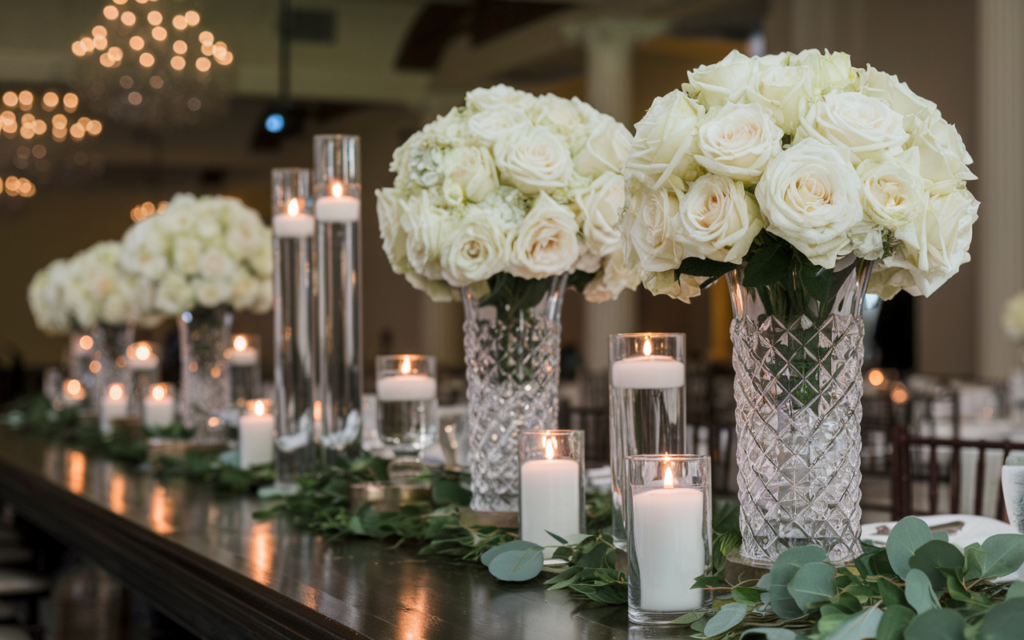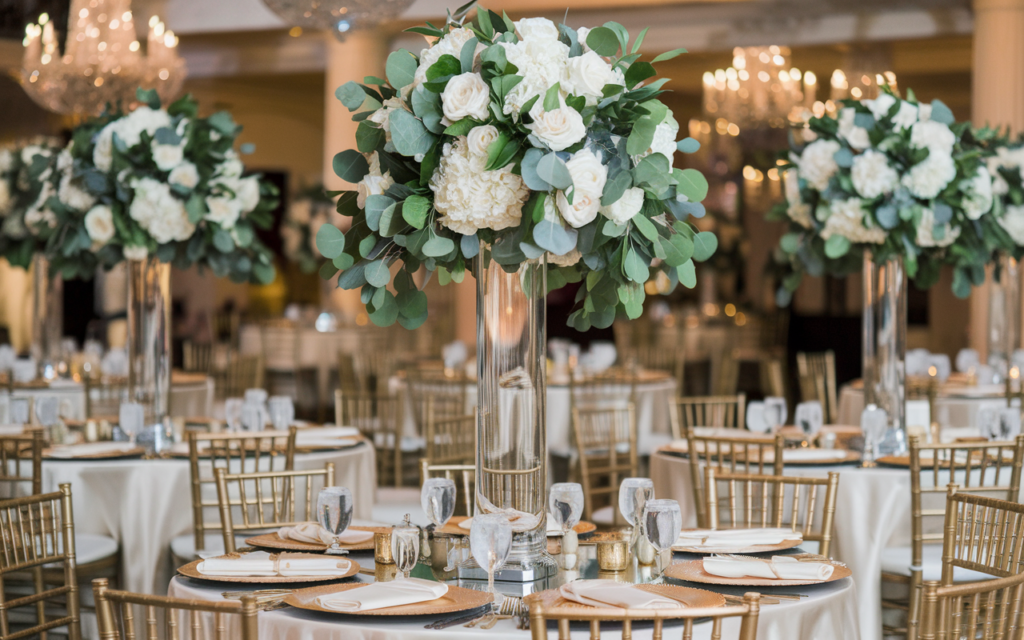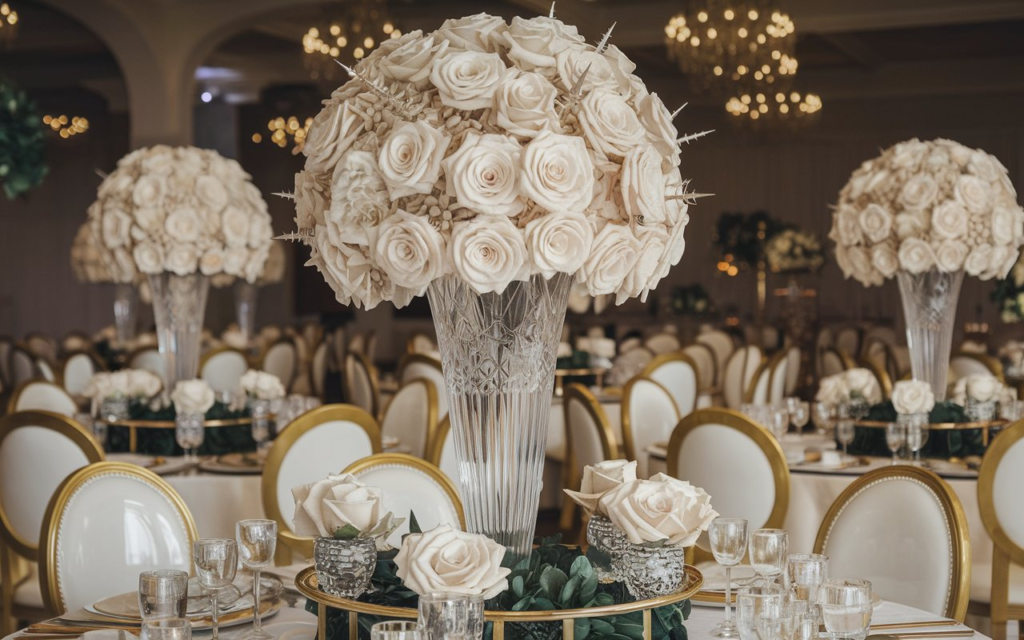Introduction
Centerpieces play a pivotal role in wedding receptions, acting as the visual anchor of each table and contributing to the overall ambiance of the event. Whether grand or minimalist, centerpieces are a significant element that reflects the couple’s style, the theme of the wedding, and even cultural or seasonal influences. Over the years, trends in wedding centerpieces have evolved, influenced by fashion, media, and the continuous quest for wedding personalization. Notably, Centerpieces at Wedding Receptions NYT has often highlighted how these elements are more than just table decor—they are statements of taste, elegance, and personality.
In recent years, centerpieces have become more than just a decorative item. They are now a medium through which couples can express their individuality, tell their love story, or convey a particular theme or message. From opulent floral arrangements to minimalist designs and sustainable options, the choices for centerpieces are as varied as the couples who choose them. This article delves into the various aspects of wedding reception centerpieces, offering a comprehensive guide that is not only informative but also optimized for those seeking inspiration and ideas online.
The Evolution of Wedding Reception Centerpieces
Wedding reception centerpieces have a rich history that reflects changing societal trends and cultural influences. In the early 20th century, centerpieces were often composed of elaborate floral arrangements, symbolizing prosperity and abundance. Flowers like roses, lilies, and orchids were popular choices, usually arranged in tall, ornate vases that added height and drama to the reception tables.
As the decades passed, wedding trends began to shift. The 1960s and 70s saw a move towards more natural and relaxed styles, with centerpieces featuring wildflowers, greenery, and simple, rustic containers. This period also marked the beginning of DIY wedding decor, as couples sought to infuse their celebrations with personal touches.
The 1980s and 90s brought back glamour with larger and more extravagant centerpieces. Crystal candelabras, mirrored bases, and an abundance of flowers were common, reflecting the era’s love for opulence and luxury. However, the new millennium saw a return to simplicity and minimalism, influenced by the rise of modern, clean aesthetics in fashion and interior design.
Today, wedding centerpieces are as diverse as ever, reflecting the wide range of styles and themes that couples embrace. From vintage-inspired arrangements to ultra-modern designs, the options are endless. Popular media, including features in the New York Times, has also played a role in shaping trends, with many couples looking to high-profile weddings and celebrity events for inspiration.

Current Trends in Wedding Reception Centerpieces
Floral Arrangements: Timeless and Elegant
Flowers have always been a staple in wedding centerpieces, and their popularity shows no signs of waning. However, today’s floral arrangements are far from traditional. Couples are increasingly opting for unique flower choices and creative arrangements that reflect their style.
Peonies, garden roses, and ranunculus are among the most popular flowers for wedding centerpieces today. These blooms are favored for their lush, romantic appearance and wide range of colors. However, there is also a growing trend towards using non-traditional flowers such as proteas, anemones, and even wildflowers, which add texture and an unexpected twist to the arrangements.
Color palettes have also evolved, with many couples choosing muted, earthy tones over the traditional bright colors. Shades of blush, dusty blue, and sage green are particularly popular, creating a soft, romantic ambiance that is perfect for modern weddings. Additionally, monochromatic arrangements, where different shades of the same color are used, are a chic and sophisticated choice.
Seasonality is another important factor in floral centerpieces. Many couples now prefer to use flowers that are in season, not only because they are more affordable but also because they are fresher and more sustainable. For example, spring weddings might feature tulips and daffodils, while autumn weddings might incorporate rich-toned dahlias and chrysanthemums.
Non-Floral Centerpieces: Creative and Unique
While flowers remain a popular choice for wedding centerpieces, many couples are looking for more unique alternatives that better fit their wedding theme. Non-floral centerpieces can be just as stunning and often offer more room for creativity.
Candles are a classic non-floral centerpiece that can add warmth and romance to any reception. Whether arranged in clusters of varying heights, floating in water, or set in lanterns, candles create a soft, intimate glow that is perfect for evening weddings. For a more modern look, geometric candle holders or sleek, minimalist designs can be used.
Another popular option is the use of decorative objects, such as vases, sculptures, or even books. These items can reflect the couple’s interests or the overall theme of the wedding. For example, a literary-themed wedding might feature stacks of antique books as centerpieces, while a modern wedding might use metallic geometric shapes.
Edible centerpieces are another trend that has gained popularity in recent years. These can include arrangements of fruits, vegetables, or even sweets, offering guests something to admire and snack on. Not only are edible centerpieces visually appealing, but they are also practical and can help reduce food waste.
Personal items or family heirlooms can also make meaningful centerpieces. For example, a couple might choose to display a collection of vintage teacups from their grandparents or a pair of antique candelabras that have been passed down through generations. These items add a personal touch to the decor and can serve as conversation starters for guests.

Eco-Friendly and Sustainable Centerpieces
As environmental awareness continues to grow, many couples are seeking ways to make their weddings more sustainable. This trend has extended to wedding centerpieces, with a focus on eco-friendly options that minimize waste and reduce the environmental impact of the event.
One popular choice is potted plants, which can be taken home by guests as favors or reused in the couple’s home after the wedding. Succulents, herbs, and small trees are particularly popular, as they are easy to care for and can thrive in a variety of environments. Potted plants also add a touch of greenery to the reception and can complement any wedding theme.
Another sustainable option is using upcycled or repurposed materials. For example, glass bottles or jars can be transformed into vases, while old books or wooden crates can be used as bases for centerpieces. These items not only reduce waste but also add a rustic, vintage charm to the decor.
Couples can also choose to rent their centerpieces rather than purchasing them outright. It is a great way to reduce waste and save money, as the items can be reused for other events. Many rental companies offer a wide range of centerpiece options, from floral arrangements to decorative objects, making it easy to find something that fits the couple’s style and theme.
Finally, some couples are choosing to forgo traditional centerpieces altogether in favor of more sustainable options. Instead of flowers or decorative objects, they might use candles or potted plants that can be repurposed after the wedding. Others might opt for a minimalist approach, using only a few key items to create a simple, elegant look.
Regional Trends in the United States
Wedding trends can also vary significantly by region within the United States. These regional differences can influence everything from the choice of venue to the style of the centerpieces.
In the Northeast, where many weddings are held in historic venues or elegant ballrooms, classic and sophisticated centerpieces are often preferred. Tall floral arrangements in crystal vases, candlelit tables, and refined color palettes are common, reflecting the region’s timeless elegance.
In the South, where weddings are often grand, traditional affairs, centerpieces tend to be larger and more elaborate. Southern weddings usually feature lush floral arrangements with flowers like magnolias, hydrangeas, and roses arranged in silver or gold vases. The use of family heirlooms or antique items as part of the centerpiece is also a popular trend, adding a touch of Southern charm to the decor.
In the Midwest, where rustic and barn weddings are popular, centerpieces often reflect the natural beauty of the region. Mason jars filled with wildflowers, wooden crates, and burlap table runners are common, creating a warm and welcoming atmosphere. The use of seasonal flowers and local produce is also a trend, highlighting the farm-to-table movement that is prevalent in the region.
On the West Coast, where outdoor weddings are popular, centerpieces often have a more casual and laid-back vibe. Succulents, driftwood, and beach-inspired elements are commonly used, reflecting the natural beauty of the coastline. Eco-friendly and sustainable centerpieces are also popular, as couples in this region are often more environmentally conscious.
DIY Wedding Centerpieces: A Personal Touch
One of the biggest trends in wedding centerpieces today is the move towards DIY (do-it-yourself) decor. Many couples are choosing to create their centerpieces not only to save money but also to add a personal touch to their wedding.
DIY centerpieces can be as simple or as elaborate as the couple desires. For those with a creative flair, crafting centerpieces can be a fun and rewarding project. It also allows couples to infuse their wedding with their personality and style, making the event truly unique.
One popular DIY option is creating floral arrangements using flowers from a local farmer’s market or even from the couple’s garden. It not only saves money but also supports local businesses and ensures that the flowers are fresh and in season. Arrangements can be as simple as a single type of flower in a mason jar or as elaborate as a mixed bouquet in a vintage vase.
Another DIY idea is to use items that have sentimental value as part of the centerpiece. For example, a couple might choose to display a collection of family photos, antique trinkets, or handmade crafts. These items can be arranged on a tray or in a shadow box, creating a centerpiece that is both meaningful and visually appealing.
For couples who want to incorporate a theme into their wedding, DIY centerpieces are a great way to bring that theme to life. For example, a couple having a beach-themed wedding might create centerpieces using sand, seashells, and candles. A couple with a love of travel might use vintage suitcases, globes, and postcards as part of their decor.
The key to successful DIY centerpieces is to start early and experiment with different ideas. Couples should also consider the logistics of creating and setting up the centerpieces on the day of the wedding. Enlisting the help of friends or family members can make the process more manageable and ensure that everything comes together smoothly.

The Role of the New York Times in Shaping Centerpiece Trends
The New York Times (NYT) has long been a source of inspiration for those planning weddings. Through its coverage of high-profile weddings, fashion trends, and expert advice, the NYT has helped to shape the way people think about wedding decor, including centerpieces.
One of the ways the NYT influences trends is through its feature articles on celebrity weddings. When a high-profile couple ties the knot, their wedding details, including the centerpieces, are often covered in detail. This coverage can set the tone for what is considered fashionable or desirable, as many couples look to celebrities for inspiration.
The NYT also features expert advice on wedding planning, including tips on choosing the right centerpieces. Articles often highlight the latest trends, offer practical advice on budgeting and logistics, and showcase innovative ideas that can help couples create a unique and memorable event.
In addition to its print coverage, the NYT’s online presence allows it to reach a wider audience, including those who are searching for wedding inspiration online. By optimizing its content for search engines, the NYT ensures that its articles on wedding trends, including centerpieces, are easily accessible to those planning their big day.
The NYT’s influence extends beyond just trends, as it also plays a role in promoting sustainability and ethical practices in the wedding industry. Through its coverage of eco-friendly weddings and sustainable decor options, the NYT encourages couples to consider the environmental impact of their choices and to opt for centerpieces that are both beautiful and responsible.
Expert Tips for Choosing the Perfect Wedding Centerpieces
Choosing the right centerpieces for a wedding can be a daunting task, as there are so many options to consider. However, with a few expert tips, couples can make the process easier and ensure that their centerpieces are a perfect reflection of their style and theme.
Consider the Venue
The venue plays a significant role in determining the style and size of the centerpieces. For example, in a grand ballroom with high ceilings, tall, dramatic centerpieces can create a striking effect. In contrast, for a more intimate setting, such as a garden or barn, smaller, more understated centerpieces may be more appropriate.
Taking into account the design of the venue is likewise significant. If the tables are close together, tall centerpieces obstruct the view and make it difficult for guests to interact. In this case, lower arrangements or even non-floral options might be a better choice.
Reflect Your Theme and Color Scheme
The centerpieces should complement the overall theme and color scheme of the wedding. For example, for a vintage-themed wedding, antique vases and lace table runners might be the perfect choice, while a modern wedding might call for sleek, minimalist designs.
Color is also an important consideration. The centerpieces should coordinate with the wedding colors, but they can be different. For a more cohesive look, consider using varying shades of the same color or incorporating complementary colors.
Balance Aesthetics and Practicality
While the centerpieces need to be visually appealing, they should also be practical. For example, if the wedding is outdoors, centerpieces should be sturdy enough to withstand wind or weather changes. If the reception includes a buffet or family-style dining, the centerpieces should be low enough to refrain from interfering with the serving of food.
Additionally, couples should consider the logistics of transporting and setting up the centerpieces. Complex or delicate arrangements might require professional assistance, while the couple or their wedding party can set up simpler designs.
Set a Budget
Wedding centerpieces can vary widely in cost, so it’s important to set a budget early on. It will help narrow down the options and ensure that the couple doesn’t overspend. For those on a tight budget, DIY centerpieces or using in-season flowers and materials can be a cost-effective option.
It’s also worth considering whether the centerpieces can serve a dual purpose. Potted plants or candles can be given to guests as favors, or the couple can choose centerpieces that can be reused in their home after the wedding.
Work with a Professional
While DIY centerpieces are a great option for some, others may prefer to work with a professional florist or event designer. These experts can help bring the couple’s vision to life, offering advice on the best flowers, materials, and designs to suit the wedding theme and budget.
Professional florists can also ensure that the centerpieces are fresh and beautiful on the day of the wedding, taking care of all the details so that the couple can focus on enjoying their special day.
Conclusion: Creating Memorable Wedding Centerpieces
Wedding centerpieces are more than just table decor—they are an integral part of the wedding experience, reflecting the couple’s style, the theme of the event, and even cultural or regional influences. Whether traditional or modern, floral or non-floral, simple or elaborate, the possibilities for centerpieces are endless.
As trends continue to evolve, influenced by media coverage, cultural shifts, and a growing emphasis on sustainability, couples have more options than ever to create centerpieces that are unique, meaningful, and memorable. By considering factors such as the venue, theme, and budget, and by seeking inspiration from sources like the New York Times, couples can ensure that their centerpieces are a beautiful and fitting addition to their wedding day.
In the end, the most important thing is that the centerpieces reflect the couple’s personality and the love they share. Whether crafted by hand or designed by a professional, wedding centerpieces are a celebration of the couple’s journey together and a beautiful way to set the stage for their new life as husband and wife.

